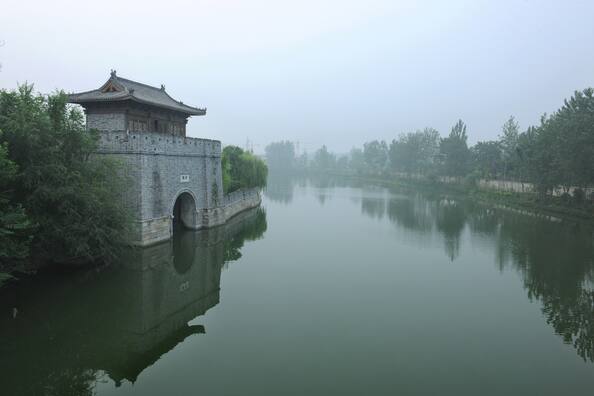The Grand Canal
The Grand Canal
The Grand Canal is a vast waterway system in the north-eastern and central-eastern plains of China, running from Beijing in the north to Zhejiang province in the south. Constructed in sections from the 5th century BC onwards, it was conceived as a unified means of communication for the Empire for the first time in the 7th century AD (Sui dynasty). This led to a series of gigantic construction sites, creating the world’s largest and most extensive civil engineering project prior to the Industrial Revolution. It formed the backbone of the Empire’s inland communication system, transporting grain and strategic raw materials, and supplying rice to feed the population. By the 13th century it consisted of more than 2,000 km of artificial waterways, linking five of China’s main river basins. It has played an important role in ensuring the country’s economic prosperity and stability and is still in use today as a major means of communication.
Description is available under license CC-BY-SA IGO 3.0
Le Grand Canal
Ce vaste système de navigation intérieure au sein des plaines de la Chine du Nord-Est et du Centre-Est s’étend de la capitale Beijing, au nord, à la province du Zhejiang, au sud. Entrepris par secteurs dès le Ve siècle av. J.-C., il fut conçu en tant que moyen de communication unifié de l’Empire à partir du VIIe siècle (dynastie Sui). Cela se traduisit par une série de chantiers gigantesques, formant l’ensemble de génie civil le plus important et le plus étendu de tous les temps préindustriels. Axe vital des voies de communication intérieures de l’Empire, il assura notamment l’approvisionnement en riz des populations et les transports de matières premières stratégiques. Au XIIIe siècle, il offrait un réseau unifié de navigation intérieure de plus de 2 000 km de voies d’eau artificielles reliant cinq des plus importants bassins fluviaux de l’espace chinois. Il a joué un rôle notable pour la prospérité économique et la stabilité de la Chine et reste encore aujourd’hui une importante voie d’échange intérieure.
Description is available under license CC-BY-SA IGO 3.0
El Gran Canal
Se trata de un vasto sistema de conducción de aguas que recorre las planicies septentrionales y centrales del este de China siguiendo una trayectoria norte-sur, desde Beijing hasta la provincia meridional de Zhejiang. Se construyó por segmentos sucesivos a partir del siglo V a.C. y bajo el reinado de la dinastía Sui, en el siglo VII de nuestra era, se proyectó transformarlo en un medio de comunicación y transporte unificado para el conjunto del Imperio. Esto dio lugar a la realización de obras gigantescas que hicieron del Gran Canal la mayor y más vasta obra de ingeniería del mundo, antes del advenimiento de la Revolución Industrial. Auténtica espina dorsal del sistema interior de comunicación y transporte del Imperio, el canal facilitó no sólo la circulación de cereales y materias primas de gran importancia, sino también el abastecimiento de las poblaciones en arroz. En el siglo XIII comprendía ya una red de vías de agua artificiales de más de 2.000 kilómetros de longitud que enlazaban las cinco cuencas fluviales más importantes de China. El Gran Canal desempeñó en el pasado un importante papel en el fomento de la prosperidad económica y la estabilidad del país y sigue siendo, hoy en día, uno de los más importantes medios de comunicación y transporte del interior de China.
source: UNESCO/CPE
Description is available under license CC-BY-SA IGO 3.0
中国大運河
中国の8つの省を貫き、北は北京から南は浙江省に至る大運河。紀元前5世紀前から建設が始まり、後7世紀の隋時代には、広大な中国内陸部を結ぶ交通網となった。その後も歴代王朝によって維持拡張され、国民への米や穀物の供給、軍事物資や軍隊の輸送に利用され続けた。建設が最盛期に達した元代の13世紀には、総延長は2000㎞以上におよんだ。産業革命前の世界最大の土木技術であり、中国で最も重要な黄河や長江を含む5つの河川流域をつなぐこの運河は、現在でも交通網として重要な役割を担っている。source: NFUAJ
Het Grote Kanaal
Het Grote Kanaal is een uitgestrekt waterwegsysteem in de noordoostelijke en centraal-oostelijke vlakten van China. Het loopt van Beijing in het noorden tot de provincie Zhejiang in het zuiden. Het kanaal werd vanaf de 5e eeuw voor Christus in gedeelten aangelegd en kreeg in de 7e eeuw A.D (Sui dynastie) voor het eerst de functie van gezamenlijk transport en verbindingssysteem voor het rijk. Dit leidde tot een serie gigantische bouwwerkplaatsen die samen ’s werelds grootste, meest uitgebreide burgerlijk bouwproject vormden voorafgaand aan de industriële revolutie. Het Grote Kanaal was de ruggengraat van het binnenlandse logistieke systeem waarmee graan, strategische grondstoffen en rijst voor de bevolking werden vervoerd. Rond de 13e eeuw bestond het uit meer dan 2000 kilometer kunstmatige waterwegen en verbond het vijf van China’s belangrijkste rivierbekkens. Het kanaal speelde een belangrijke rol in de zekerstelling van de economische voorspoed en stabiliteit van China en speelt ook nu nog een belangrijke rol in de interne verbindingen van het land.
Source: unesco.nl
